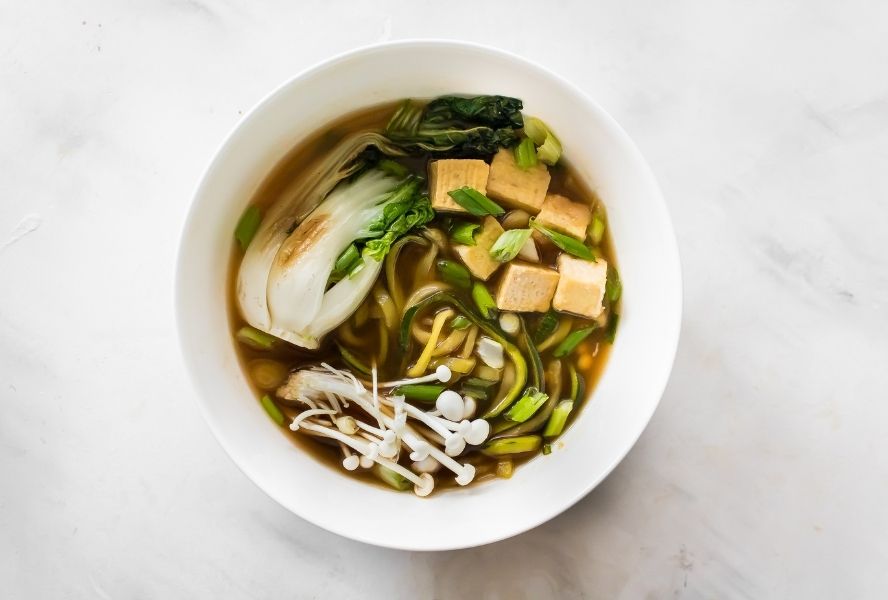
Deceptively simple and unassuming, tofu hides a range of tastes and textures that vary from custardy and creamy to pungent and umami-packed. Although tofu can be used as a dairy substitute or the basis of an easy vegan dinner, there’s so much more it offers. Here’s a quick, introductory guide to shopping, preparing and serving different types of tofu, from silken to firm.
Related: A Guide to Dried Black Mushrooms
What is tofu?
Tofu comes in many forms, although most of them begin the same way: soy milk is heated and coagulated to form curds, then pressed into a block. The differences in tofu depend on the amount of time it is pressed and how much moisture is extracted. Variations in texture and the tofu’s ability to absorb liquid make each type suitable to specific dishes — both Chinese and Japanese cuisine include tofu preparations that celebrate the richness and purity of silken tofu, for example, or use firmer options for deep frying to crispy perfection.
Where is tofu used?
Tofu is used across Asia, from Korean sundunbu jiggae (spicy soft tofu stew, fiery with gochucharu flakes) to the ubiquitous Japanese agedashi tofu (lightly tempura based tofu with a light aromatic broth) or Sichuan mapo tofu (spicy oil-slicked ground meat with tofu).
Related: Getting To Know Lap Cheong (Chinese Dried Sausage)
Where can I shop for tofu?
Most major grocery chains now carry tofu in some form, found either in the dairy or produce sections. For the full range of the options listed below, however, you’ll likely need to head to an Asian supermarket or other specialty grocer, where there are often frozen options, dried and jarred versions on the shelves, and a dedicated cold section of fresh tofu (don’t forget to check out the store’s hot food section, which also often offers cooked varieties).
How should tofu be stored?
Fresh tofu, no matter the type, should be stored in the refrigerator and used before its due date. Although fresh tofu, especially silken or soft, can be eaten raw, some cooks do give it a quick microwave to take off the chill (unless it is a cold preparation as described below).

Get the recipe: 5-Minute Cold Spicy Tofu
What kinds of tofu are there?
Creamy silken tofu can be enjoyed raw or slightly warmed, served by itself or with a variety of pickled vegetables or other toppings. Its lush texture also lends well to blending and adding depth and a dairy-like mouthfeel to vegan dishes, smoothies or soups.
Related: The Best Ways to Shop, Prepare and Cook Chinese Greens
Soft tofu is often confused with silken tofu and the textures are similar, but a true connoisseur will be able to spot the slight differences in terms of creamy, slippery texture on the palate. Both soft and silken tofu can often be used interchangeably in applications, and are sold in blocks in water, either in tubs or sealed packs. These types of tofu, due to their fresh nature, often have a relatively short lifespan and should be enjoyed quickly.

Get the recipe: Tofu and Hotdog Fried Rice
Medium firm and firm tofu are sturdier forms that have been pressed to release excess moisture to hold together better when cooking, but with a little less suppleness in texture. Super-pressed extra-firm tofu can even be crumbled to resemble ground meat and used as a topping for noodles or deep fried as a protein on its own. They are often sold in vacuum sealed blocks or packs and can last a little longer than their softer counterparts.
The distinctive yellow hue of egg tofu gives a hint as to the soft and yielding rich egginess within. This type of tofu is often sold in cylindrical tubes (pay attention to the cutting instructions on the label to improve your chances of getting it out in one intact piece). Egg tofu is often sliced into discs and pan-fried with a thin coating of cornstarch or rice flour for an extra textural element and layer of crunch.
Tofu puffs are lighter and airier due to the deep frying they undergo. Often sold frozen in packages, fried tofu puffs are a delightful addition to soups or hotpot, where they bob to the surface and add heft and protein to the meal.
Dried tofu skins are a byproduct of heating the soy milk in the initial coagulation process, where a skin forms on the surface that is then skimmed off and dried. The resulting sticks, sold in stores in vacuum packed bags, are shelf-stable and best used in braised dishes, soups and stews.

Get the recipe: Vegan Tofu Ramen
Fermented tofu, packed with salt and alcohol in a brine, is sold in jars as plain or spicy. This pungent preserved good that’s used more as a seasoning than a main ingredient, and like fish sauce, a little goes a long way to season vegetables or provide a depth of flavour to other dishes.
So next time you buy tofu, think beyond the vegan substitutes and honour the ingredient in its own right — there’s plenty of options to unpack in one little block.
Read more: A Guide to Chinese Noodles
